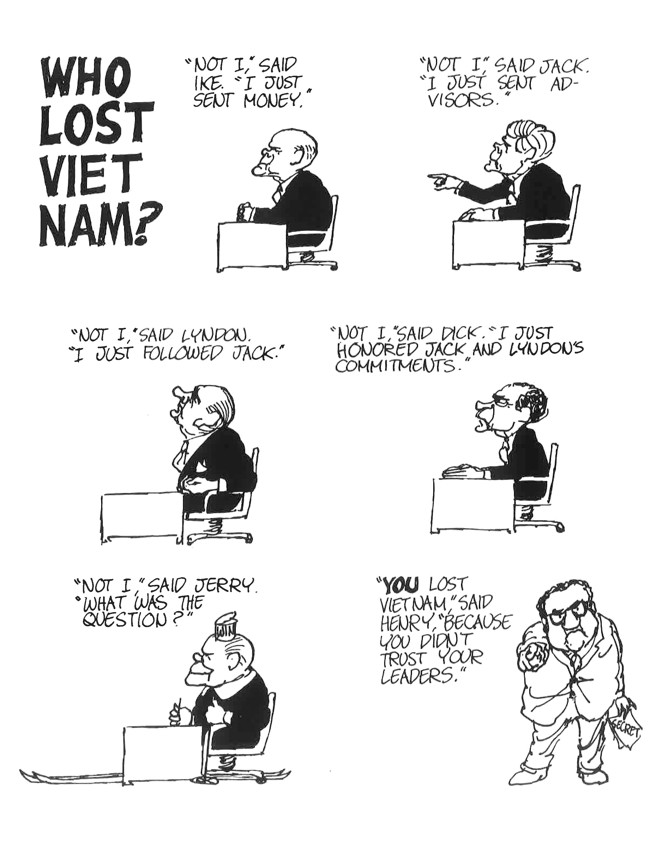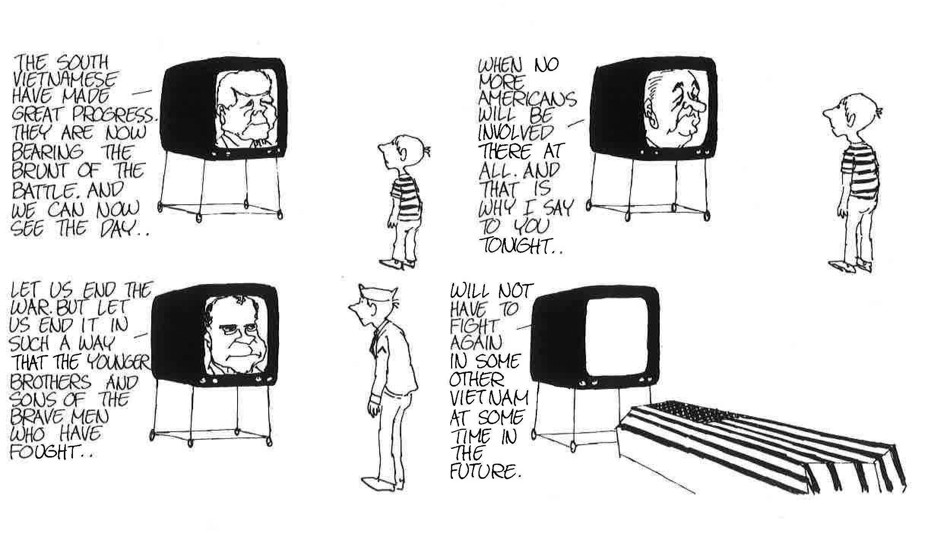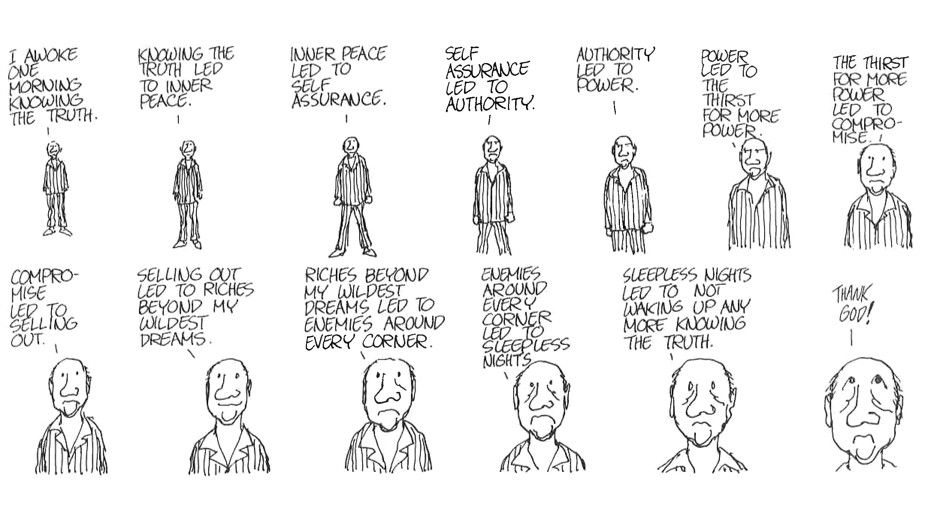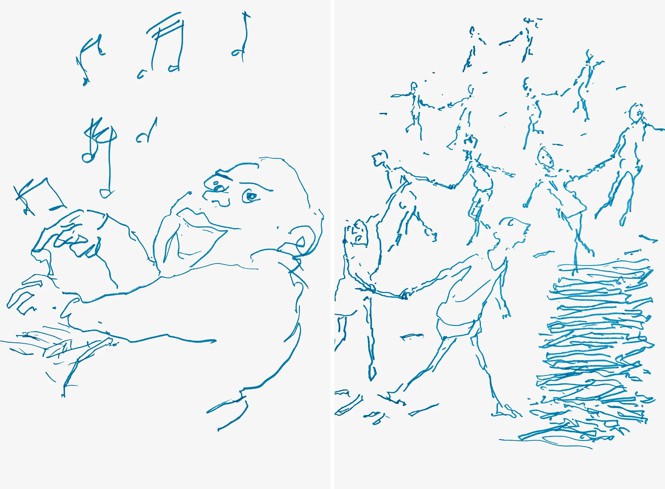
Jules Feiffer and I were born 94 years ago in the Bronx, two months apart. We both grew up to be terrible at sports, and we both started to draw characters from the comics when we were 8 or 9 years old. We both became cartoonists, and last year, both of us ended up in different emergency rooms with heart failure, in the same week.
After four or five days, we were both discharged from the hospital with pretty much the same array of pills, as well as orders to stay away from salt. But Jules’s doctor gave him an additional admonishment: Jules had to move far away from his home on Shelter Island. The humidity was bad for his lungs. Joan Holden, Jules’s wife, wasted no time in doing research to find out which area had the best air quality. It turned out that the air around Cooperstown, New York, was about as good as you could get, so Joan and Jules bought a house in a nearby town.
I live in Manhattan but was determined to pay Jules a visit—we have been friends for half a century, and I was the best man when Jules married Joan. And, in a way, I owe the career I’ve had as a caricaturist to Jules. His work as a cartoonist, a novelist, a playwright, and a creator of children’s books over the past 70 years inspired me to attempt things I never would have without his example.
In 1956, when his strip in The Village Voice began appearing, I was an art director at CBS Television designing ads for I Love Lucy, Amos ‘n’ Andy, and other shows that I found unwatchable. Suddenly, there was Jules’s strip every week, describing the way we lived—our hang-ups, our desires, our fears, our politics. He was doing what I dreamed of doing: using comic art as commentary. Before my 27th birthday, I quit CBS and started freelancing.
It’s difficult for a generation younger than mine to realize how important Jules’s drawings were to so many of us in America in the 1950s and ’60s. There were some great cartoonists, but not so much when it came to the kind of sophisticated social and political commentary we now take for granted. The era of Doonesbury and The Simpsons, which Jules helped make possible, had yet to come. Jules created and occupied a space of his own: part editorial cartoon, part comic strip, part session on the couch. His style—his line, his language—was deceptively simple, and unlike anything else at the time. Across several panels, one character would give voice to a monologue, two characters would hold a conversation, or a woman would dance amid her swirling thoughts—rarely more than that. In the 1950s, newspaper cartoons didn’t really focus on relationships, therapy, conformity, self-doubt, or the latest fads in lifestyle and literature. In the early ’60s, even liberal newspapers were nervous about the civil-rights movement and virtually unanimous in their support of the Vietnam War. Because Jules was a lone voice of protest for so long, he was revered by many readers.

After Jules and Joan moved into their new home, Joan emailed me photographs, and I promised I would visit. But I didn’t see how I could. The drive there would take more than four hours, and I had promised my daughter (after badly denting her car) that I would never get behind the wheel again. Jules’s driving days were over too: He had macular degeneration. To the rescue came my friend Katherine Hourigan, a vice president of Knopf Doubleday and a good friend of Jules’s. Kathy offered to drive me to Joan and Jules’s place in upstate New York.
The events that led to my friendship with Jules began in 1974, when Clay Felker, a co-founder and the editor of New York magazine, bought The Village Voice, the countercultural weekly that had started publication in 1955. Back then, freelancers who wrote for the Voice liked to call it a “writer’s newspaper” because, as they described it, their stories went into print pretty much unedited. On the other hand, those lucky contributors, including cartoonists, made little or no money. The Voice’s unofficial policy seemed to be “We don’t edit you, and we don’t pay you.” When, in 1956, the editors agreed to run Jules’s comic strip—at first called Sick, Sick, Sick—he was ecstatically happy to accept $0 a week just to get published. After Felker took over the Voice, its low-paid staff joined a union, and Jules’s salary jumped to $25 a week.
Another result of the Voice changing hands was that Felker gave me—a contributor to New York magazine since its very beginning—a weekly spot in the Voice. Jules and I would now be appearing just a page apart every week. This put us in the position of being dueling cartoonists, but Jules’s parry-slash-and lunge had made him famous long before I joined the paper. His celebrated comic strip—now called simply Feiffer—was being syndicated in newspapers from coast to coast, as well as overseas in The Observer. The film director Stanley Kubrick was so taken by Jules’s strip that he wrote to him praising his “eminently speakable and funny” dialogue. He suggested that they collaborate on a screenplay.
Instead, Jules used his gift for dialogue to write a novel, Harry, the Rat With Women, and followed that with a play, Little Murders. The latter was turned into a movie in 1971, the same year that another film, Carnal Knowledge, for which Jules wrote the screenplay, opened in theaters. Despite his dizzying array of creative undertakings—his critical history The Great Comic Book Heroes; his illustrations for The Phantom Tollbooth; and the Oscar-winning animated film Munro, about a little boy who is drafted into the Army—Jules never missed a deadline in the 41 years that his cartoon strip appeared in the Voice.

In the 1970s, when we met at parties or spoke on the same panel, we were always friendly, but we did not become close friends until Jules met my wife, Nancy. It was easy for a boy from the Bronx to be attracted to Nancy: Her voice was warm and soft, and her speech was clearly enunciated. She radiated what Quakers call “inner light,” and—best of all—she had been a fan of Jules’s since her college days. Jules figured that if Nancy had married me, I must be more interesting than he’d thought.
One summer, Kathy Hourigan invited Nancy and me to the cottage she rented on Martha’s Vineyard, and Jules, who had a large, turn-of-the-century saltbox house, invited us all to dinner. When Nancy told Jules how much she admired his home, he explained that he had bought it with the $650,000 he’d picked up for writing the Carnal Knowledge screenplay, adding that he had initially written it for the stage but “rewrote it for the screen because Mike Nichols said he would rather direct it as a movie.” Jules made it sound so easy to write a screenplay that I promised myself that as soon as I got back to Manhattan, I would learn how to type.
Having the Feiffer strip and my own cartoon a page apart in the Voice worked out well. Even when we both tackled the same subject in the same issue, our approach was very different. Most of the time, I felt I held my own against Jules’s sequential drawings, but not when it came to the war in Vietnam. On that subject, Jules couldn’t be touched. The attempt by Truman, Eisenhower, Kennedy, Johnson, and Nixon to force Christian dictators down the throats of Buddhist Vietnamese in the name of anti-communism produced many brilliant cartoons from many pens, but none with more rage, wit, and concision than Jules’s.

Unfortunately, my happy stay at the Voice was short-lived. In 1977, Rupert Murdoch bought a controlling interest in New York and the Voice, and Felker was gone. I resigned, along with many other contributors. Feiffer saw no reason to leave the Voice, and Murdoch never interfered with his strip. In 1986, Jules finally won the Pulitzer Prize for Editorial Cartooning. After 30 years of brilliant graphic commentary, it was long overdue. “Every 30 years,” Jules said at the time, “the Pulitzer committee gives me a prize, whether I deserve it or not.”
Jules and I were thrown together again in 1992, when Tina Brown took over the editorship of The New Yorker. Tina saw nothing wrong with going after celebrated writers and cartoonists who had made their reputation outside the magazine’s hallowed halls; she wanted Jules Feiffer, and gave him two pages to do a strip for her first issue. I contributed the cover for that issue.
The Monday it hit the newsstands, Jules and I were bowled over when the magazine was delivered to us by messenger. I have no idea how many other contributors received a copy by hand, but such gestures on Tina’s part were the first indication I had that concern for the bottom line was very low on her list of priorities. Although I had broken into the The New Yorker a year earlier, I phoned Jules, and we congratulated each other on making it into the magazine that had snubbed us when we were young.
Jules continued to have triumphs in the years ahead, but he also had troubles. His screenplay for Popeye didn’t turn out the way he’d hoped, and some of his later plays received lukewarm reviews. He also had to cope with a long, acrimonious divorce. And then there was the brutal fact that his eyesight was failing.

After four hours of driving from one boring highway to another, we were told by the car’s GPS that we had arrived at Joan and Jules’s home. Kathy and I found ourselves in front of a very long one-story house that Joan later described as neoclassical or Gustavian. No one answered our knock, so we just walked in. We soon discovered Joan in the kitchen; she welcomed us with hugs and rushed to find Jules in the other wing, and we followed. When he saw us—or the blurred image of us—he let out his familiar high-decibel shout of joy, and we all returned to the kitchen. The house has enormous picture windows with a spectacular view of a lake and the voluptuous mountains beyond it. I wondered how much of the view Jules could actually enjoy, though he had spoken enthusiastically about seeing his home’s surroundings for the first time.
After lunch, Jules and I spent time together in his studio. “This is the biggest studio I ever had,” Jules roared at the top of his lungs as we entered. I guess he wanted his friends in Manhattan to hear—they’d all told him not to move out of the city. I’m not sure Jules could afford to live in Manhattan anymore; the divorce had drained his savings. The one time he’d tried to make a little extra money by drawing a strip for an advertisement, he’d received a letter calling him “a sellout,” and that was enough to make Jules swear off ever doing another ad. The great New Yorker cartoonists Peter Arno, Charles Saxon, and Charles Addams had all drawn for advertising agencies, and nobody had ever called them sellouts. But the followers of Jules expected their hero to be above drawing for a whiskey ad.
As I sat with Jules, I saw a lot of taped-up boxes from the move that he still hadn’t opened. But one of my drawings from my book The Saturday Kid had been unpacked and was hanging on his wall; I’d given it to Jules years ago as a peace offering. That book had come close to ruining our friendship.
This was decades ago, but here’s what happened. I had called Jules and asked if he would consider writing a book, which I would illustrate, about a poor boy in the 1930s who goes to the movies every Saturday morning and daydreams himself into those movies. Jules jumped at the idea and promised I’d have copy in a week or two. After six months went by, I decided I could write the book myself. That’s when his copy arrived. It was mostly about a boy with a terrible mother. It was Jules’s mother, not mine. I told him I couldn’t do his book. He felt betrayed and went off to write his own book for children, The Man in the Ceiling, which was brilliant and became a best seller, as did most of his other children’s books. He forgave me.
Jules brought over a few drawings that he had done recently. I found out later that the essayist Roger Rosenblatt was using them in his new book, Cataract Blues. Looking at the thin lines crossing this way and that, it was hard for me to figure out what exactly Jules meant to convey, but his work, done in blue ink, had a quality that reminded me of some Paul Klee drawings. One of them seemed to me to be of three bridges, perhaps ones that cross the East River. I told Jules they were lovely, and they were. But they didn’t look anything like those assured, energetic drawings that I so admired.

Before Kathy and I got in the car to drive back to New York, Joan and Jules walked out with us and pointed to their barn. It was temperature-controlled—a previous owner had used it to store paintings and wine. It is intended to become a repository for many of Jules’s original drawings, currently in storage in New York City. The archive encompasses seven decades of our national life, or at least a version captured with India ink on Bristol board. Maybe the Smithsonian will come calling.







